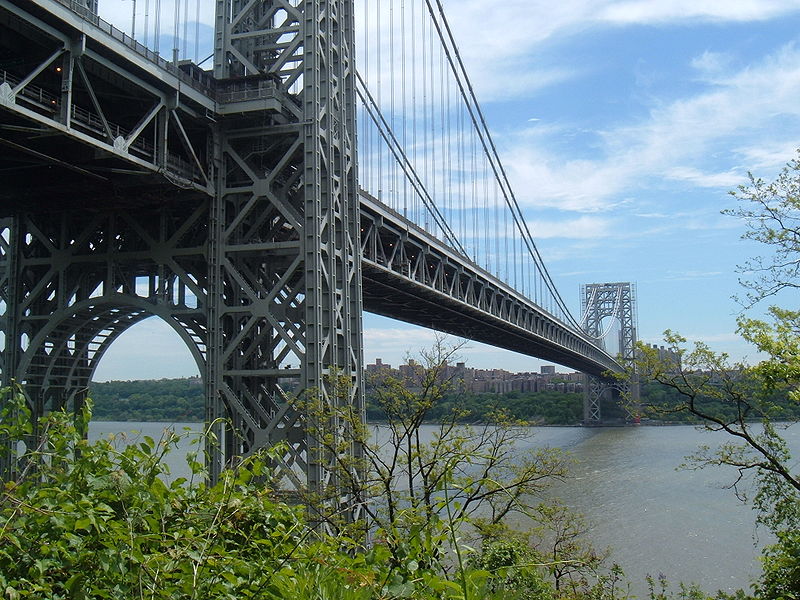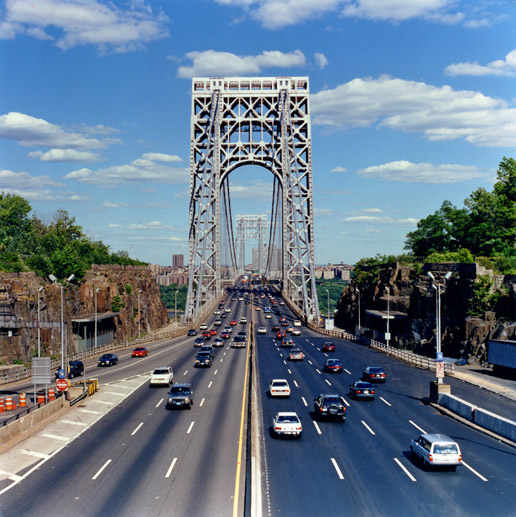George Washington Bridge
The George Washington Bridge (known informally as the GW Bridge, the GWB, the GW, or the George) is a suspension bridge spanning the Hudson River, connecting the Washington Heights neighborhood in the borough of Manhattan in New York City to Fort Lee in New Jersey by means of Interstate 95, U.S. Route 1/9. U.S. Route 46, which is entirely in New Jersey, ends halfway across the bridge at the state border. The GWB is considered one of the world's busiest bridges in terms of vehicle traffic. The bridge carried 107,912,000 vehicles in 2007, according to the Port Authority of New York and New Jersey — the bi-state government agency that owns and operates several area bridges, tunnels, and airports.

The GW span is the fourth longest suspension bridge in the United States. It contains two levels — an upper level with four lanes in each direction and a lower level with three lanes in each direction, for a total of 14 lanes of travel. Additionally, the bridge houses a path on each side of the bridge's upper level for pedestrian traffic. The speed limit on the bridge is 45 mph (70 km/h), though congestion often slows traffic, especially during the morning and evening rush hours.


George Washington Bridge
Carries 14 lanes (8 upper, 6 lower)
of I-95/US 1/US 9/US 46, pedestrians and bicycles
Crosses Hudson River
Locale Fort Lee, New Jersey and Manhattan in New York City
Design Double-decked Suspension bridge
Longest span 3,500 ft (1,100 m)
Total length 4,760 ft (1,450 m)
Width 119 ft (36 m)
Height 604 ft (184 m)
Vertical clearance 14 ft (4.3 m) (upper level), 13.5 ft (4.1 m) (lower level)
Clearance below 212 ft (65 m) at mid-span
Opening date October 24, 1931 (upper level) August 29, 1962

History
Groundbreaking for the new bridge began in October 1927, a project of the Port of New York Authority. Its chief engineer was Othmar Ammann, with Cass Gilbert as architect. The bridge was dedicated on October 24, 1931, and opened to traffic the following day. Initially named the "Hudson River Bridge," the bridge is named in honor of George Washington, the first President of the United States. The Bridge is near the sites of Fort Washington (on the New York side) and Fort Lee (in New Jersey), which were fortified positions used by General Washington and his American forces in his unsuccessful attempt to deter the British occupation of New York City in 1776 during the American Revolutionary War. Washington evacuated Manhattan by crossing between the two forts. In 1910 the Washington Chapter of the Daughters of the American Revolution erected a stone monument to the Battle of Fort Washington. The monument is located about 100 yards (91 m) northeast of the Little Red Lighthouse, up the hill towards the eastern bridge anchorage.pix USS Nautilus passes under the George Washington Bridge in 1956, when the bridge only had a single deck.

When it opened, the bridge had the longest main span in the world; at 1,067 m (3,500 ft), it nearly doubled the previous record of 564 m (1,850 ft), which had been held by the Ambassador Bridge. (The record has since been exceeded numerous times.) The total length of the bridge is 1,451 m (4,760 ft). As originally built, the bridge offered six lanes of traffic, but in 1946, two additional lanes were provided on what is now the upper level. A second, lower deck, which had been anticipated in Ammann's original plans, was added, opening to the public on August 29, 1962. This lower level has been waggishly nicknamed "Martha." The additional deck increased the capacity of the bridge by 75 percent, making the George Washington Bridge the world's only 14-lane suspension bridge, providing eight lanes on the upper level and six on the lower deck.


The original design for the towers of the bridge called for them to be encased in concrete and granite. However, due to cost considerations during the Great Depression and favorable aesthetic critiques of the bare steel towers, this was never done. The exposed steel towers, with their distinctive criss-crossed bracing, have become one of the bridges most identifiable characteristics. Le Corbusier (Charles-Edouard Jeanneret) said of the unadorned steel structure: "The George Washington Bridge over the Hudson is the most beautiful bridge in the world. Made of cables and steel beams, it gleams in the sky like a reversed arch. It is blessed. It is the only seat of grace in the disordered city. It is painted an aluminum color and, between water and sky, you see nothing but the bent cord supported by two steel towers. When your car moves up the ramp the two towers rise so high that it brings you happiness; their structure is so pure, so resolute, so regular that here, finally, steel architecture seems to laugh. The car reaches an unexpectedly wide apron; the second tower is very far away; innumerable vertical cables, gleaming against the sky, are suspended from the magisterial curve which swings down and then up. The rose-colored towers of New York appear, a vision whose harshness is mitigated by distance." (When the Cathedrals were White, 1947.)
Following the September 11th attacks on New York and Washington, the Port Authority prohibited people from taking photographs on the premises of the bridge due to the fear that terrorist groups might study any potential photographs in order to plot a terrorist attack on the bridge. Such prohibitions have since been lifted. As the enclosed lower level is more vulnerable to hazardous material (HAZMAT) incidents than the upper level, most HAZMATs have been prohibited there even before the September 11th attacks. If weather allows, on Martin Luther King, Jr. Day, Presidents Day, Memorial Day, Flag Day, Independence Day, Labor Day, Columbus Day, and Veterans Day, as well as on dates honoring those lost in the September 11, 2001 attacks, the bridge sports the largest free-flying American flag in the world; 90 feet (27 m) long and 60 feet (18 m) wide, the flag weighs 450 pounds (200 kg).